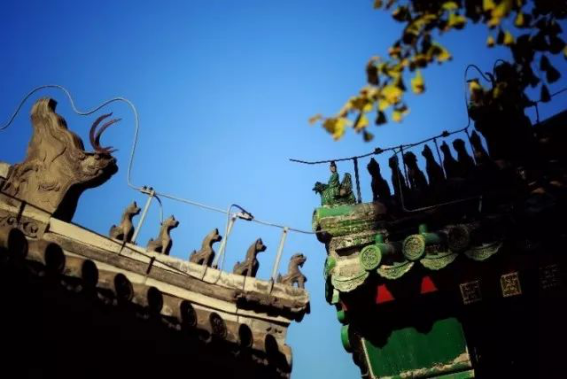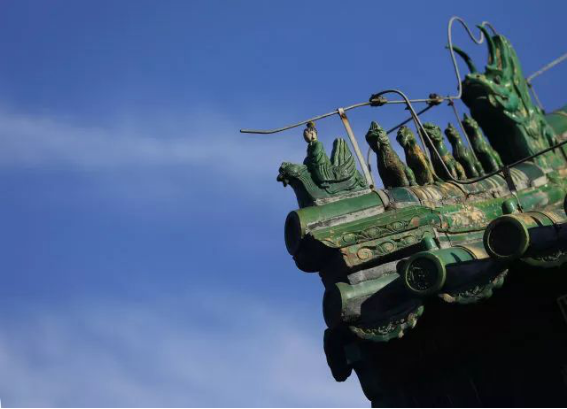
When visiting Prince Kung’s Palace, look up and you’ll find various ceramic mythical creatures lining the roof ridges.

Roof ridge of the ancient architecture of Prince Kung’s Palace
These ceramic creatures, arranged in a sequence on the roof ridges of an architectural structure (including at both ends of the horizontal ridge and end of each of the four sloping ridges), serve as symbolic protectors of the residence’s owners. Their purpose is to ward off disasters, transform misfortune into fortune, expel evil spirits, and uphold justice.
With their various shapes and lively posture, these figures enhance the beauty of the soaring eaves, adding vibrancy and charm. But despite their metaphorical and decorative significance, it's important to note that their primary function is to secure the roof tiles in place.
The arrangement of these small creatures follows strict rules, with their number varying according to the hierarchical rank, or significance, of the piece of architecture.
The alignment on a sloping roof ridge starts with an immortal riding a phoenix at the lowest end, followed by a group of seated mythical beasts in single-digit odd numbers, variably from one to nine, and ends with a horned beast. The number indicates the significance of the building – the more beasts there are, the more important the building is.
Each creature bears a unique name and carries a specific meaning, as explained below:
Immortal riding a phoenix: Also known as “immortal riding a chicken”, its main function is to secure the first tile at the lower end of the ridge.
Dragon: The dragon is a mythical animal in ancient legends, with deer’s antlers, fish’s scales, and eagle’s talons. It can control clouds and rain. In ancient times, the dragon was an incarnation of the emperor.
Phoenix: The phoenix is the king of birds in legends. The male is called feng, and the female is called huang. Collectively, they are referred to as fenghuang (phoenix), signifying auspiciousness. In ancient times, it served as a metaphor for people with divine virtues.
Lion: When lions roar, other animals submit to them. The lion is the king of the mountain, symbolizing bravery and stateliness. In Buddhism, the lion symbolizes the immense power of Buddhist teachings. Here, the lion is an auspicious beast embodying both fierceness and benevolence.
Heavenly horse: The heavenly horse is a divine horse and a paragon of auspiciousness in Chinese mythology. During the Han Dynasty (206 BC-AD 220), steeds of exceptional quality from the Central Asia were affectionately known as “heavenly horses”, representing nobility and prestige. The inclusion of the heavenly horse among roof ridge members further enhances their grandeur and commanding presence.
Sea horse: The sea horse is an auspicious embodiment in ancient mythology, representing traits such as loyalty, bravery, and good fortune. It is believed to possess wisdom and virtue that transcend boundaries, spanning from the heavens above to the vast depths of the sea, and extending its influence in all directions.
Suanni: According to ancient records, the suanni is a fierce beast similar to a lion, and is capable of devouring tigers and leopards. It has the power of leading all other beasts. Another belief holds that suanni is one of the nine sons of the dragon, and has a fondness for flames. As a result, the suanni often appears as a decorative figure on incense burners, symbolizing its role in safeguarding peace and harmony.
Yayu: The yayu is a sea creature that can spout jets of water. Its presence suggests the power to bring wind and rain, and to prevent or extinguish fire.
Xiezhi: The xiezhi is known as a divine sheep with a single horn and is also referred to as the “one-horned sheep”. As explained in dictionaries, the xiezhi is a mythical creature that can use its horn to hit people who are at fault. Because of its ability to discern right from wrong and its incomparable strength, censors in ancient China wore official hats bearing the xiezhi to demonstrate their ability to make fair judgments. The inclusion of the xiezhi among the group of mythical creatures on the roof ridge signifies its embodiment of fairness, impartiality, and its ability to suppress evil.
Douniu: The douniu is a legendary creature resembling a dragon without horns. It serves a similar purpose to the yayu. Another belief holds that the douniu has the power to subdue water and so was often placed in areas prone to flooding in ancient times. Placing the douniu on the roof ridge aims to suppress evil forces and protect the house from harm.
Hangshi: The hangshi is a winged, monkey-faced creature with a downward-held tail and a vajra (a symbolic Buddhist weapon) in its hand. It is said that the vajra possesses the power to subdue demons. Its name is derived from its position as the tenth creature in the ranking. It resembles the legendary Thunder God and symbolizes protection of the house against thunder. In ancient architecture, the hangshi can only be found adorning the roof ridge of the Hall of Supreme Harmony in the Forbidden City.
Chuishou: Also referred to as the corner beast, the chuishou is positioned at the end of the beast group along the gable ridges. It takes the form of a beast’s head, covering the iron nails used to secure the roof tiles on the ridge from sliding and strengthen the junction of the roof ridges.
Chiwen: On both ends of the horizontal ridge, there are dragon head-shaped roof tiles called zhengwen or chiwen that face inward. It is said that this creature has an affinity for swallowing objects, which is why they are installed at the ends of the central ridge, appearing as if their mouths are devouring the ridge. Some say the chiwen is a sea creature that delights in high places, has the ability to spout water like rain, and is unfazed by fire. By incorporating the chiwen as a decorative element, it is believed that water can be brought forth to suppress fire and ensure safety.
Not all structures have as many as ten mythical figurines on their roof ridges. The number of the creatures varies according to the significance of the structure. The omission starts from the back of the line, while the dragon in the front is relatively stable and not easily removed. In general, the dragon, phoenix, lion, heavenly horse, sea horse, and suanni are staples.

The immortal riding a phoenix, dragon, phoenix, lion, heavenly horse, sea horse and the chuishou line a sloping roof ridge of a structure in Prince Kung’s Palace